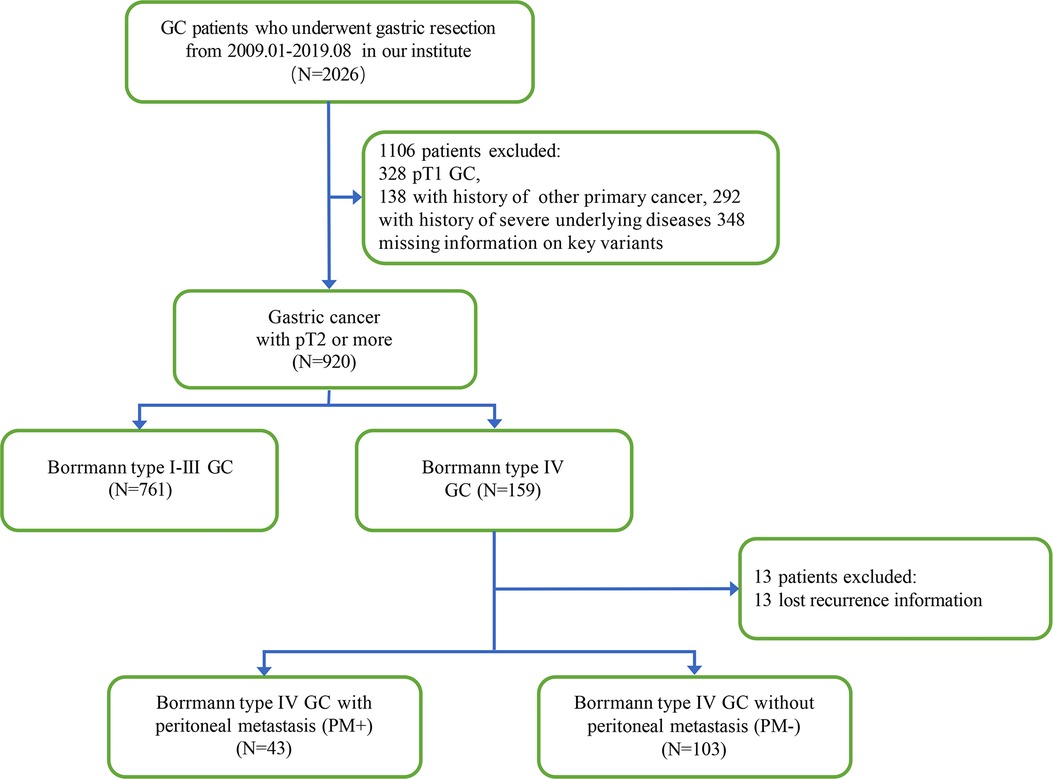- 1Department of Surgical Oncology, The First Affiliated Hospital, College of Medicine, Zhejiang University, Hangzhou, China
- 2Department of Gastrointestinal Surgery, Lishui Hospital, College of Medicine, Zhejiang University, Lishui, China
Background: The clinicopathological features and surgical treatment strategies of Borrmann type IV gastric cancer (GC) remain controversial. Peritoneal metastasis is the most common recurrence pattern in patients with Borrmann type IV GC.
Methods: Among 2026 gastric cancer between January 2009 and August 2019, 159 cases of Borrmann type IV GC were included in this study (7.8%). We retrospectively analyzed the clinicopathological characteristics and prognosis of these patients. Univariate and multivariate Cox proportional hazards were applied to identify independent prognostic factors. Predictors related to peritoneal metastasis of type IV GC were analyzed by multivariate Cox regression analysis.
Results: Borrmann type IV gastric cancer was associated with more advanced clinicopathological features at diagnosis than the other Borrmann type GC. Of the 159 patients with Borrmann type IV GC, the median OS was 23 months. The number of patients with peritoneal metastasis was 43, accounted for 27.0% of all the patients and 87.8% of the patients with distant metastasis. Multivariate analyses revealed lymph node metastasis to be independent prognostic factor for survival in Borrmann type IV GC patients. pN3b and tumor size > 50 mm showed to be risk factors for peritoneal metastasis.
Conclusions: Borrmann type IV GC is an important independent prognostic factor. pN3b is an independent prognostic factor and a predictor of peritoneal metastasis in patients with Borrmann type IV GC.
Introduction
Gastric cancer (GC) is one of the most common malignancies in the world, with more than 1.8 million new cases worldwide in 2020 and an estimated 770,000 deaths, making it the fifth most frequently diagnosed cancer and the fourth in mortality (1). The Borrmann type proposed in 1926 provides a relatively accurate description of the gross morphology of advanced gastric cancer (2), among which Borrmann type IV GC accounts for about 8%–13% (3–6). Borrmann type IV GC, including linitis plastica, are characterized by poorly differentiated tumor cells with diffusely infiltrative involvement of the stomach (5, 7, 8). The patients were frequently associated with poor tumor differentiation, lymph node metastases, peritoneal metastases, serosal invasion, lymphatic invasion, and poor prognosis (4, 9–11). Peritoneal metastasis (PM) represents the most common type of recurrence in advanced GC and is considered as an independent factor for poor prognosis (12). Although the treatments of peritoneal metastasis in gastric cancer have made some progress, its prognosis is still poor (13, 14). Early detection and intervention are still the main way to prolong the life of patients. Lee et al. reported that Borrmann type IV gastric cancer is an independent risk factor for peritoneal recurrence (15). However, in Borrmann type IV GC, the risk factors of peritoneal recurrence have not been well studied. Prognostic factors have the potential to play an important role in improving health, including clinical practice, healthcare research, and the development, evaluation, and targeting of interventions (16). Therefore, in our study, we described the clinicopathological features of Borrmann type IV gastric cancer and focus on the risk factors for PM in this special type of gastric cancer.
Material and methods
Probands
Between January 2009 and August 2019, 2026 gastric cancer patients underwent gastric resection at the department of surgical oncology, the First Affiliated Hospital, Zhejiang University. Among these patients, 159 cases of Borrmann type IV GC were included in further analysis (7.8%). In addition, 761 cases of Borrmann type I–III GC were selected for comparison with Borrmann type IV GC. The inclusion criteria for patients were as follows: (i) patients diagnosed with gastric cancer with pT2 or more from January 2009 to August 2019; (ii) patients received radical gastrectomy or palliative gastrectomy in the department of surgical oncology; and (iii) patients had complete clinical data and pathologic specimens available for reevaluation. The exclusion criteria for patients included: (i) patients diagnosed with combined primary malignant cancer; (ii) patients had history of severe underlying diseases; and (iii) missing information for key variants. The specific patient selection pathway is shown in Figure 1. Each patient was consented to collecting research data once the hospital file is created. Outcomes of our interest, that is, overall survival (OS) and time to first recurrence (RFS), were collected during the follow-up period (median follow-up time 38 months, ranging from 1 month to 122 month). 18 Borrmann type IV GC patients were lost in post-operative follow-up. Age, gender, CEA and CA19-9 level before surgery, surgical intervention, pathological features including histological type, tumor location, tumor size, depth of tumor invasion and lymph node metastasis, were retrospectively collected from the medical record system of our institution. The tumors were staged according to the eighth edition of AJCC/UICC TNM staging system.
Statistical analysis
The clinicopathological features between Borrmann type IV GC and Borrmann type I–III GC were compared using Chi-square or Fisher's exact test. Log-rank tests were used to analyze survival curves which were created using Kaplan-Meier analysis. Information obtained from the univariate analysis was applied to a survival analysis with covariates using the Cox model of proportional hazards (forward likelihood ratio model). Subsequently, Cox proportional hazard regression (enter model) was used to examine the effect of different clinicopathological features and treatment on PM in patients with Borrmann type IV gastric cancer and predict the independent risk factors of PM in such patients. Statistical analysis was performed using SPSS 26.0 software. In all statistical analyses, P < 0.05 was considered significant.
Results
Characteristics of Borrmann type IV GC patients
Borrmann type IV GC patients showed significant differences in the distribution of gender, operation type, surgical curability, tumor size, differentiation, depth of invasion, lymph node metastasis, distant metastasis and stage comparing with other Borrmann types of gastric cancer (Supplementary Table S1). Multivariate analysis showed that Borrmann type IV GC was an independent prognostic factor (Supplementary Figures S1, S2 and Supplementary Table S2) after adjusting for age, gender, residual tumor, differentiation, TNM stage, serum CEA and CA19-9 level. The clinicopathological features of Borrmann type IV GC patients are shown in Table 1. Of 159 patients with Borrmann type IV GC who underwent gastrectomy, 89 (56.0%) were male and 70 (44.0%) were female. The mean age was 59-year-old (range 16 to 87). Total gastrectomy was performed in 97 patients (61.0%) and subtotal gastrectomy was performed in 62 patients (39.0%). D2/D2 + lymphadenectomy was applied to all stage I–III patients. 7 patients received D2 lymph node dissection including splenectomy because of tumor invasion. The average number of lymph nodes examined was 26.8. Among the 26 patients diagnosed as stage IV, 8 patients received palliative resection due to gastrointestinal bleeding or obstruction and others were found to have distant metastasis during the operation or post-operative pathology confirmed distant metastasis. 12 cases (7.6%) underwent extended surgical resection due to tumor invasion or concurrent indications for resection. Among these patients, 115 patients received at least 1 cycle of first-line chemotherapy (platinum- or taxane-based), in which 25 patients received neoadjuvant chemotherapy and 109 patients received adjuvant chemotherapy. The purpose of these patients receiving chemotherapy included not only preoperative drawdown and postoperative adjuvant, but also conversion chemotherapy.
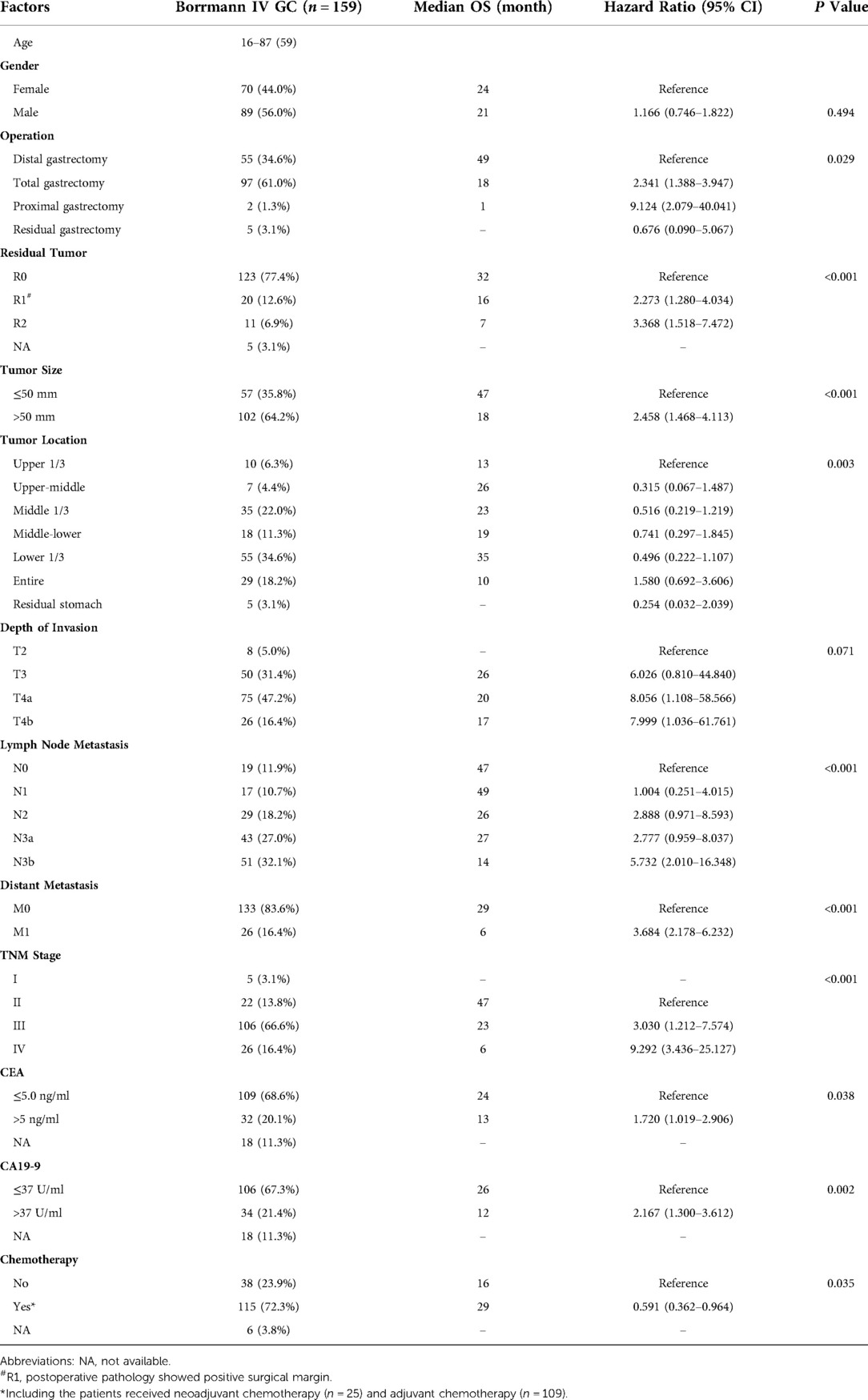
Table 1. Clinicopathological features and survival analysis of patients with Borrmann type IV gastric cancer.
Prognostic significance of Borrmann type IV GC
The median OS of patients with Borrmann type IV GC was 23 months, and the 5-year survival rate was 25.1% (Supplementary Figure S3). Univariate Cox analysis revealed that residual tumor, tumor size, lymph node metastasis, distant metastasis, serum CEA and CA19-9 level were significantly associated with OS (Table 1 and Supplementary Figures S4A–F). Multivariate analysis showed that N category and distant metastasis were the independent prognostic factors (Figure 2A) after adjusting for age, CEA, CA199 and tumor size. As for patients who received R0 resection, only distant metastasis was the independent prognostic factors after adjusting for age, lymph node metastasis, CEA, CA199 and tumor size (Figure 2B). Notably, pN3b was associated with the worst prognosis, which was significantly worse than pN3a (Table 1 and Figure 3A).
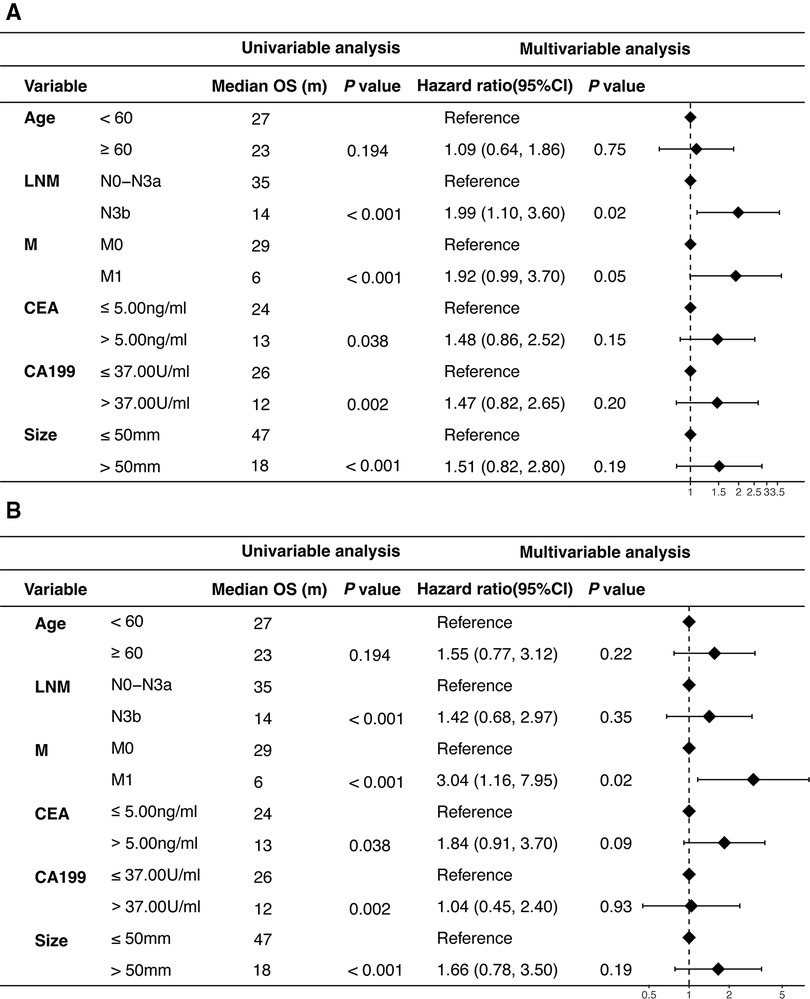
Figure 2. Cox proportional hazard regression models and forest plot for overall survival. (A) Forest plot displaying the results of hazard ratio for overall survival of patients with Borrmann type IV gastric cancer; (B) Forest plot displaying the results of hazard ratio for overall survival of patients with B-4 GC after receiving R0 resection. (LNM, lymph node metastasis; M, distant metastasis; CI, confidence interval).
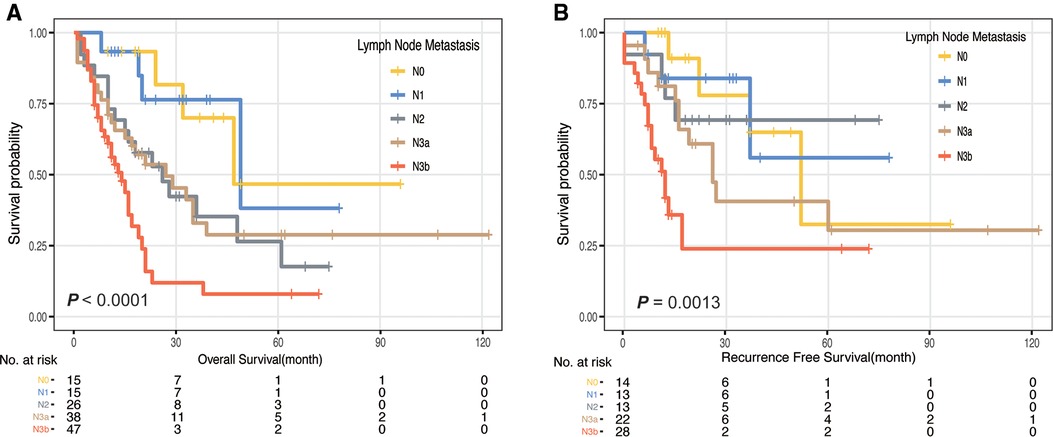
Figure 3. Kaplan-Meier curve of pN stage. (A) Kaplan-Meier curves of overall survival (OS) according to N category in Borrmann type IV gastric cancer. (B) Kaplan-Meier curves of recurrence-free survival (RFS) according to N category in Borrmann type IV gastric cancer.
Risk factors for peritoneal metastasis of Borrmann type IV GC
43 patients developed PM, accounting for 27% of all patients and 87.8% of the patients with distant metastasis. Among them, 23 patients had synchronous PM and 20 developed metachronous PM (peritoneal recurrence). The median OS of patients with PM was significantly shorter than that of patients without PM (16 months vs. 29 months, P = 0.001, Supplementary Figure S5). The 3-year survival rate was 12.7%. 1-year survival rate of patients with synchronous PM was 22.5% and that of patients who develop metachronous PM (peritoneal recurrence) was 77.4%. The median OS after metachronous PM was 11 months. Among 159 patients with Borrmann type IV GC, 103 patients were followed up to date or died without peritoneal recurrence or metastasis. To investigate the risk factors for PM in patients with Borrmann type IV GC, we selected these 103 patients and 43 patients with PM for comparative analysis. The clinicopathological features are presented in Table 2. Through univariate Cox analysis, we found that there were significant differences in the prognosis and recurrence risk between pN3b and other N categories (Figures 3A,B). Therefore, when discussing the risk factors for peritoneal recurrence, we divided the N category into N0-3a and N3b with lymph node metastasis >15 as cut-off value.
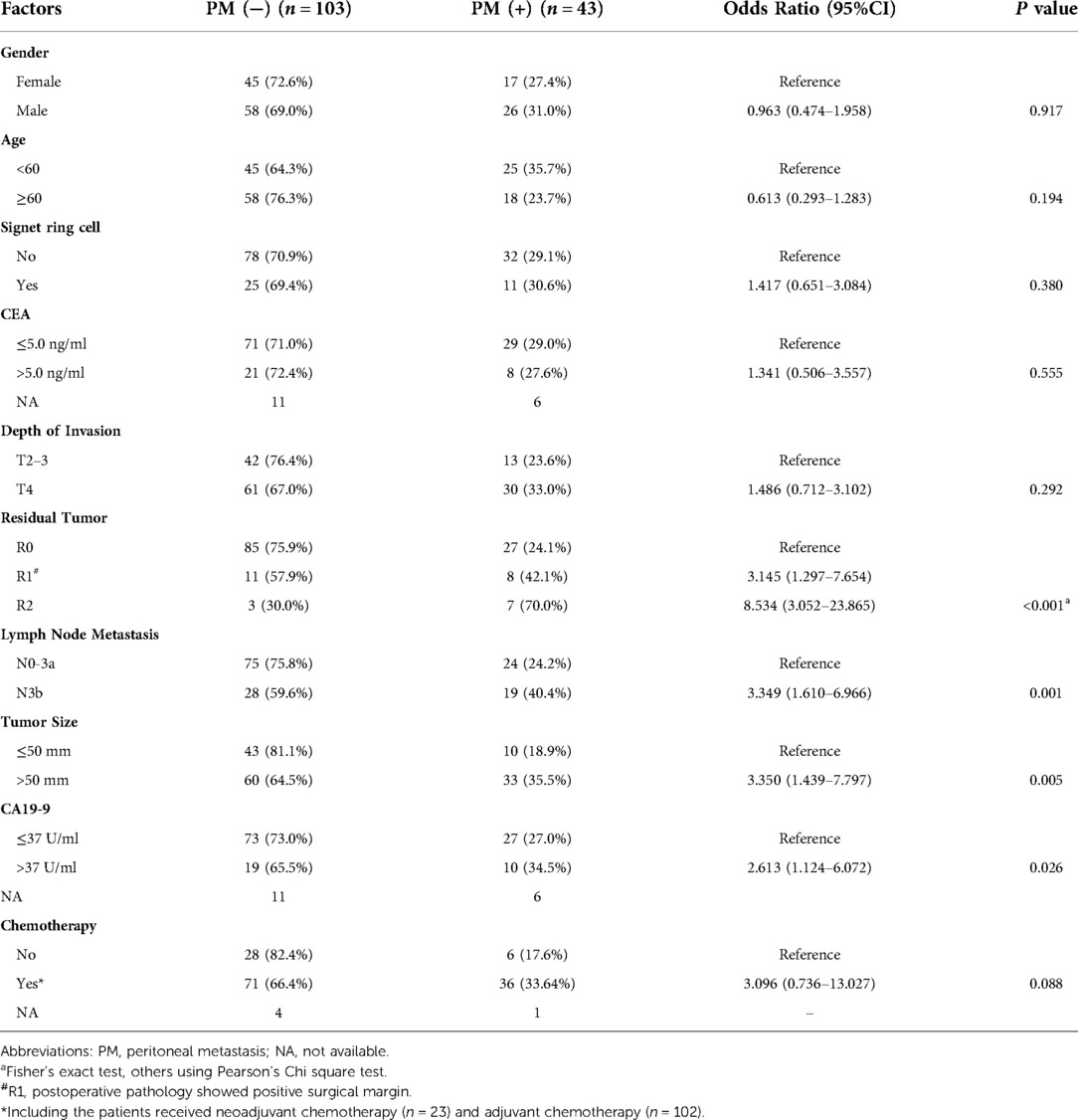
Table 2. Clinicopathological features between PM (+) and PM (−) patients with Borrmann type IV gastric cancer.
Univariate Cox analysis showed that factors related to PM were regional lymph node metastasis, tumor size, residual tumor and preoperative CA19-9 level (Table 2). Multivariate cox regression analysis revealed that pN3b (P = 0.04) and tumor size >50 mm (P = 0.03) were the independent risk factors of PM after adjusting for age and CA199 (Figure 4A). Meanwhile, univariate and multivariate analysis was also performed separately for the patients who received R0 resection (Supplementary Table S3 and Figure 4B). The results indicated that pN3b and signet ring cell carcinoma were significant risk factors for peritoneal recurrence of Borrmann type IV GC.
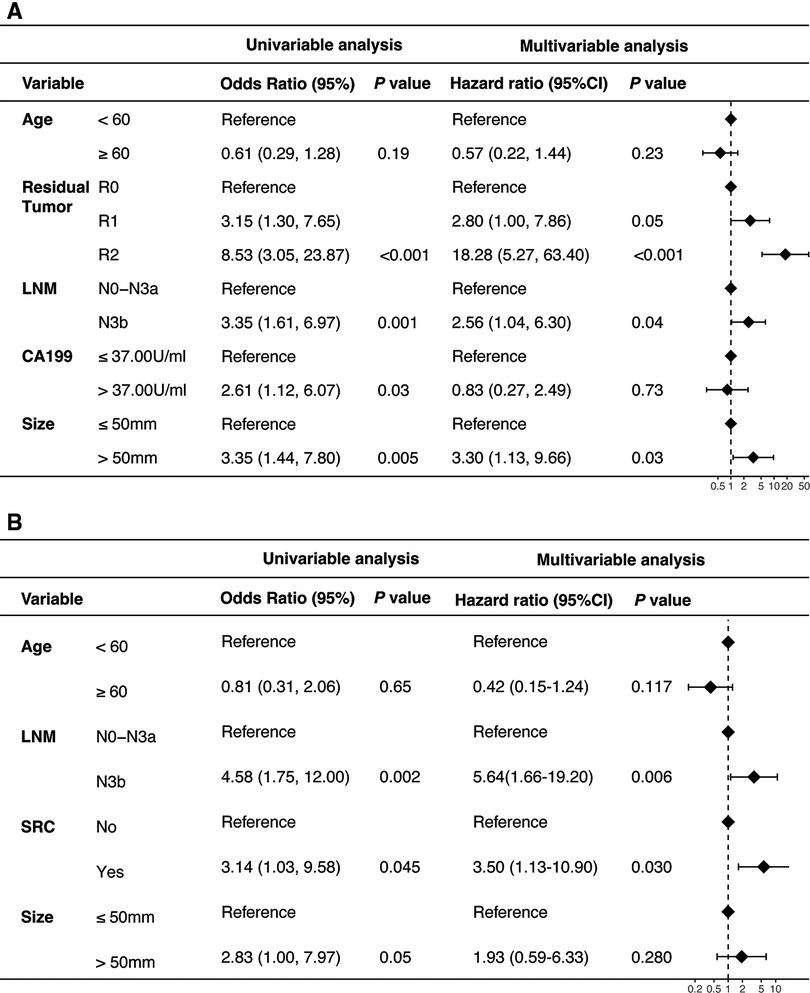
Figure 4. Cox proportional hazard regression models and forest plot for recurrence free survival. (A) Forest plot of data from multivariate cox regression revealing factors independently associated with peritoneal metastasis of patients with Borrmann type IV gastric cancer. (B) Forest plot of data from multivariate cox regression revealing factors independently associated with peritoneal metastasis of patients with Borrmann type IV gastric cancer after receiving R0 resection. (LNM, lymph node metastasis; SRC, signet ring cell; CI, confidence interval).
Discussion
The incidence of Borrmann type IV gastric cancer has a large deviation in previous reports, ranging from 8 to 20% (3, 4, 9). In recent years, many relevant studies have shown that Borrmann type IV gastric cancer was characterized as higher female/male ratio, poorer differentiation, higher risk of serosal infiltration, lymph node metastasis and peritoneal metastasis, and poor prognosis (4, 9). Lee et al. reported that Borrmann type IV gastric cancer is an independent risk factor for peritoneal recurrence (15). In this study, we mainly included patients who underwent gastrectomy, and the incidence of Borrmann type IV GC was about 7.8%. Due to the aggressiveness of Borrmann type IV GC, many patients had already lost the opportunity for surgical treatment when they were diagnosed, so our incidence rate was slightly lower than that shown in relevant reports. Many studies have reported the prognostic factors of Borrmann type IV GC. For instance, Yamashita et al. suggested that elder age, T category, N category, peritoneal dissemination, CY1/CYX and margin status are prognostic factors of Borrmann type IV GC, in which elder age, T category and peritoneal dissemination are independent prognostic factors (17). Univariate analysis by Yook et al. found that tumor location, occupied region, invasion depth, lymph node metastasis and pTNM stage were correlated with the prognosis of Borrmann type IV gastric cancer after radical surgery (18). The multivariate analysis indicated that only tumor location and pTNM stage were independent factors affecting the prognosis of Borrmann type IV gastric cancer after radical surgery. In this study, a multivariate analysis of 159 patients showed that pN3b (P = 0.03), along with residual tumor, was a significant independent prognostic factor of Borrmann type IV GC, which was basically consistent with previous reports. The treatment options for Borrmann type IV GC are difficult and controversial because of its high incidence of peritoneal metastasis and poor prognosis. Early detection of Borrmann IV gastric cancer by endoscope remain difficult due to the diffuse invasion of cancer cells to the mucosa lamina propria and no obvious ulcer or mucosal surface uplift (3, 8). At diagnosis, cancer cells often penetrate the serous membrane and have lymph node metastasis. Curative resection (R0 resection) is critical for treatment of this GC subtype (4, 5).
Previous reports have shown that nearly 20% of patients with GC were diagnosed with PM before or during surgery, and about 50% of patients developed PM after radical surgery (19, 20). Patients with PM had a poor prognosis with a median OS of less than 2 years (19, 21). PM eventually lead to refractory ascites, intestinal obstruction and cachexia, which are the main causes of death of gastric cancer (20). Many clinical studies have investigated the risk factors of PM in GC. Huang BJ et al. suggested that patients with Borrmann III/IV and N3 should be closely followed to detect peritoneal metastasis (22). Several other studies have shown a significantly close relationship between lymph node metastasis and PM (23, 24). Among the characteristics of Borrmann type IV GC, it is worth noting that the incidence of PM is much higher than other types (9). This is also one of the main reasons for the poor prognosis of this GC subtype. It is noteworthy that the tendency of Borrmann type IV to develop PM was concurrent with a lower risk of liver metastasis, suggesting a specific pattern of metastasis (9). Consistently, among 49 who developed distant metastasis in our cohort, 43 (87.8%) developed PM but only 3 (6.1%) developed liver metastasis. Otsuji E et al. considered lymph node metastasis as an independent risk factor for PM of Borrmann type IV GC in 1999 in a cohort of 150 patients (25). In addition, Dong RZ et al. concluded that extracapsular lymph node spread (ECS) is an independent prognostic factor and an adverse factor for PM in patients with Borrmann type IV gastric cancer with radical resection (3). Otherwise, there are few studies focus on the risk factors associated with peritoneal metastasis of Borrmann type IV GC. In this study, we found that regional lymph node metastasis and tumor size were the variables that independently correlated with PM. Furthermore, pN3b and signet ring cell carcinoma were the independent predictor of PM in patients who had received R0 resection (peritoneal recurrence).
Among several clinicopathologic factors, the tumor size clinically served as a simple predictor of tumor progression (26). Previous study reported that tumor size was strongly correlated with the depth of invasion, degree of lymph node metastasis, and stage of the disease. Saito et al. (27) reported that tumor size might be a good indicator in the prediction of recurrence site as well as serve as a simple predictor of survival of patients with gastric cancer. These results indicate that tumor size provides important information about the malignant potential of tumors. Patients with larger tumors may need more aggressive treatment and more frequent postoperative re-examination.
Gastric signet ring cell carcinoma (GSRC) is a typical diffuse infiltrating gastric cancer with low differentiation, strong invasiveness and poor prognosis (28–31). Most of GSRCs were Borrmann type III and IV gastric cancer (30). Previous studies [6,8] found that GSRC showed a higher incidence of peritoneal metastasis (30, 32) and was an independent factor affecting lymph node metastasis (32), while the latter was an independent prognostic factor of advanced GC (32). These results suggest that one of the reasons for the poor prognosis of gastric SRCC is the tendency of lymph node metastasis. In our study, GSRC was an independent risk factor of peritoneal recurrence which suggested that carefully follow-up examinations and more aggressive treatment may be necessary for Borrmann type IV GC with SRC after surgery.
Regional lymph node metastasis played an important role in predicting prognosis and peritoneal recurrence in our study, especially pN3b. The American Joint Committee on Cancer (AJCC) TNM staging system is currently recognized as the best malignant tumor staging system in the world, and its latest 8th edition was published in October 2016, replacing the 7th edition since 2009 (33–35). Although the 7th edition divided N3 into N3a and N3b, it did not impact the TNM staging of GC. However, a study of over 25,000 GC patients from 15 countries found that N3a and N3b two subgroups of patients with significant differences of its survival. Subsequently, in the updated 8th edition of TNM staging system, N3a and N3b largely impact the tumor staging (33, 35). The new grading system has been validated in national databases to verify its predictive power and accuracy (36–39). Some studies have identified that patients with pN3a and pN3b presented distinct survival outcomes (34, 40), which is consistent with our results (Table 1 and Supplementary Table S4). Yonemura Y. et al. reported trans-lymphatic metastasis as one of the PM formation concepts (41). In our study, univariate Cox analysis showed that pN3b was significantly different from other N stages in predicting prognosis and peritoneal recurrence in Borrmann type IV GC (Figures 3A,B). This might be because more tumor cells exist in patients with lymph node metastasis, spreading through the lymphatic system, also patients with pN3b indicates a more locally advanced disease, which might thus be accompanied by a higher incidence of transperitoneal spread. Therefore, we conclude that for patients with Borrmann type IV GC, lymph node metastasis greater than 15 is a better cut-off value to predict poor prognosis and high incidence of peritoneal recurrence. Thus, we could make more effort for these patients in order to improve their prognosis. Firstly, routine gastroscopy physical examination and early detection of cancer without lymph node metastasis may be effective means of prevention. Secondly, for patients with N3b indicated by preoperative imaging examination, it is more necessary to perform neoadjuvant therapy and more active treatment measures including prophylactic intraperitoneal chemotherapy to achieve the purpose of a better prognosis. Last but not least, more intensive follow-up for N3b patients may be meaningful for early detection and intervention of metachronous peritoneal metastasis to improve the outcomes of patients with Borrmann type IV GC.
Whereas, there are some limitations of our study. This study is a retrospective and single-institution study and only those patients who referred to our hospital for surgery were enrolled. A very few patients had less than 16 lymph nodes dissected due to the lack of standardization of surgical methods in the early years. For Borrmann I–III GC, we lacked some information on recurrence, making it difficult for us to make a more accurate comparison. These limitations can lead to biases that may affect the accurate evaluation. A multicenter, prospective study is needed to validate these results in a larger population in future. Also, neoadjuvant therapy plays an important role in the treatment of Borrmann type IV GC due to its malignant biological behavior. However, pN stage is inferred from pathological findings which might not be disadvantageous in choosing treatment options.
Conclusion
In summary, retrospective analysis of clinicopathological factors in Borrmann type IV GC revealed that lymph node metastasis, specifically pN3b, as an independent prognostic factor. Lymph node status and tumor size were identified as independent predictors of PM. Importantly, pN3b is an important predictive factor for worse prognosis and peritoneal recurrence after radical surgery in patients with Borrmann type IV GC.
Data availability statement
The raw data supporting the conclusions of this article will be made available by the authors, without undue reservation.
Ethics statement
The studies involving human participants were reviewed and approved by Ethics Committee of The First Affiliated Hospital, College of Medicine, Zhejiang University (No. IIT20210588A). The patients/participants provided their written informed consent to participate in this study. Written informed consent was obtained from the individual(s) for the publication of any potentially identifiable images or data included in this article.
Author contributions
YC and YC are responsible for the study concept and design. YC and LW are responsible for the acquisition of data and the development of methodology. YC, XC and YC are responsible for the analysis and interpretation of data. YC, LT and YC are responsible for the writing of the manuscript, HW and LT are responsible for the review and/or revision of the manuscript. All authors contributed to the article and approved the submitted version.
Funding
This work was supported by grants from: Project of the regional diagnosis and treatment centre of the Health Planning Committee (No. JBZX-201903), Science and Technology Project of Zhejiang Province (2021C03119), Chinese Medicine Technology Project of Zhejiang Province (2020ZZ013) and Youth Project of Zhejiang Provincial Natural Science Foundation (LQ18H160012).
Conflict of interest
The authors declare that the research was conducted in the absence of any commercial or financial relationships that could be construed as a potential conflict of interest.
Publisher's note
All claims expressed in this article are solely those of the authors and do not necessarily represent those of their affiliated organizations, or those of the publisher, the editors and the reviewers. Any product that may be evaluated in this article, or claim that may be made by its manufacturer, is not guaranteed or endorsed by the publisher.
Supplementary material
The Supplementary Material for this article can be found online at: https://www.frontiersin.org/articles/10.3389/fsurg.2022.986696/full#supplementary-material.
References
1. Sung H, Ferlay J, Siegel RL, Laversanne M, Soerjomataram I, Jemal A, et al. Global cancer statistics 2020: gLOBOCAN estimates of incidence and mortality worldwide for 36 cancers in 185 countries. CA Cancer J Clin. (2021) 71(3):209–49. doi: 10.3322/caac.21660
2. Borrmann R Geschwulste des magens und des duodenums. In: Henke F, Lubarsch O, editors. Handbuch spez pathol anat und histo. Berlin: Springer Verlag (1926). p. 812–1054.
3. Dong RZ, Guo JM, Zhang ZW, Zhou YM, Su Y. Prognostic impact and implications of extracapsular lymph node spread in borrmann type IV gastric cancer. Oncotarget. (2017) 8(57):97593–601. doi: 10.18632/oncotarget.18400
4. An JY, Kang TH, Choi MG, Noh JH, Sohn TS, Kim S. Borrmann type IV: an independent prognostic factor for survival in gastric cancer. J Gastrointest Surg. (2008) 12(8):1364–9. doi: 10.1007/s11605-008-0516-9
5. Kim DY, Kim HR, Kim YJ, Kim S. Clinicopathological features of patients with borrmann type IV gastric carcinoma. ANZ J Surg. (2002) 72(10):739–42. doi: 10.1046/j.1445-2197.2002.02523.x
6. Huang JY, Wang ZN, Lu CY, Miao ZF, Zhu Z, Song YX, et al. Borrmann type IV gastric cancer should be classified as pT4b disease. J Surg Res. (2016) 203(2):258–67. doi: 10.1016/j.jss.2016.04.026
7. Furukawa H, Hiratsuka M, Iwanaga T. A rational technique for surgical operation on borrmann type 4 gastric carcinoma: left upper abdominal evisceration plus Appleby's Method. Br J Surg. (1988) 75(2):116–9. doi: 10.1002/bjs.1800750209
8. Zhao X, Huang K, Zhu Z, Chen S, Hu R. Correlation between expression of leptin and clinicopathological features and prognosis in patients with gastric cancer. J Gastroenterol Hepatol. (2007) 22(8):1317–21. doi: 10.1111/j.1440-1746.2007.04941.x
9. Luo Y, Gao P, Song Y, Sun J, Huang X, Zhao J, et al. Clinicopathologic characteristics and prognosis of Borrmann type IV gastric cancer: a meta-analysis. World J Surg Oncol. (2016) 14(1):49. doi: 10.1186/s12957-016-0805-9
10. Chen CY, Wu CW, Lo SS, Hsieh MC, Lui WY, Shen KH. Peritoneal carcinomatosis and lymph node metastasis are prognostic indicators in patients with borrmann type IV gastric carcinoma. Hepatogastroenterology. (2002) 49(45):874–7.12064011
11. Zhu YL, Yang L, Sui ZQ, Liu L, Du JF. Clinicopathological features and prognosis of Borrmann type IV gastric cancer. J BUON. (2016) 21(6):1471–5.28039710
12. Chu DZ, Lang NP, Thompson C, Osteen PK, Westbrook KC. Peritoneal carcinomatosis in nongynecologic malignancy. A prospective study of prognostic factors. Cancer. (1989) 63(2):364–7. doi: 10.1002/1097-0142(19890115)63:2%3C364::AID-CNCR2820630228%3E3.0.CO;2-V
13. Bonnot PE, Piessen G, Kepenekian V, Decullier E, Pocard M, Meunier B, et al. Cytoreductive surgery with or without hyperthermic intraperitoneal chemotherapy for gastric cancer with peritoneal metastases (CYTO-CHIP study): a propensity score analysis. J Clin Oncol. (2019) 37(23):2028–40. doi: 10.1200/JCO.18.01688
14. Fujitani K, Yang HK, Mizusawa J, Kim YW, Terashima M, Han SU, et al. Gastrectomy plus chemotherapy versus chemotherapy alone for advanced gastric cancer with a single non-curable factor (REGATTA): a phase 3, randomised controlled trial. Lancet Oncol. (2016) 17(3):309–18. doi: 10.1016/S1470-2045(15)00553-7
15. Lee JH, Son SY, Lee CM, Ahn SH, Park DJ, Kim HH. Factors predicting peritoneal recurrence in advanced gastric cancer: implication for adjuvant intraperitoneal chemotherapy. Gastric Cancer. (2014) 17(3):529–36. doi: 10.1007/s10120-013-0306-2
16. Riley RD, Hayden JA, Steyerberg EW, Moons KG, Abrams K, Kyzas PA, et al. Prognosis research strategy (PROGRESS) 2: prognostic factor research. PLoS Med. (2013) 10(2):e1001380. doi: 10.1371/journal.pmed.1001380
17. Yamashita K, Hosoda K, Katada N, Moriya H, Mieno H, Higuchi K, et al. Survival outcome of Borrmann type IV gastric cancer potentially improved by multimodality treatment. Anticancer Res. (2015) 35(2):897–906.25667472
18. Yook JH, Oh ST, Kim BS. Clinicopathological analysis of Borrmann type IV gastric cancer. Cancer Res Treat. (2005) 37(2):87–91. doi: 10.4143/crt.2005.37.2.87
19. Katai H, Ishikawa T, Akazawa K, Isobe Y, Miyashiro I, Oda I, et al. Five-year survival analysis of surgically resected gastric cancer cases in Japan: a retrospective analysis of more than 100,000 patients from the nationwide registry of the Japanese gastric cancer association (2001–2007). Gastric Cancer. (2018) 21(1):144–54. doi: 10.1007/s10120-017-0716-7
20. Yonemura Y, Bandou E, Kawamura T, Endou Y, Sasaki T. Quantitative prognostic indicators of peritoneal dissemination of gastric cancer. Eur J Surg Oncol. (2006) 32(6):602–6. doi: 10.1016/j.ejso.2006.03.003
21. Nashimoto A, Akazawa K, Isobe Y, Miyashiro I, Katai H, Kodera Y, et al. Gastric cancer treated in 2002 in Japan: 2009 annual report of the JGCA nationwide registry. Gastric Cancer. (2013) 16(1):1–27. doi: 10.1007/s10120-012-0163-4
22. Huang B, Sun Z, Wang Z, Lu C, Xing C, Zhao B, et al. Factors associated with peritoneal metastasis in non-serosa-invasive gastric cancer: a retrospective study of a prospectively-collected database. BMC Cancer. (2013) 13:57. doi: 10.1186/1471-2407-13-57
23. Yoshida M, Sugino T, Kusafuka K, Nakajima T, Makuuchi R, Tokunaga M, et al. Peritoneal dissemination in early gastric cancer: importance of the lymphatic route. Virchows Arch. (2016) 469(2):155–61. doi: 10.1007/s00428-016-1960-7
24. Tanaka T, Kumagai K, Shimizu K, Masuo K, Yamagata K. Peritoneal metastasis in gastric cancer with particular reference to lymphatic advancement; extranodal invasion is a significant risk factor for peritoneal metastasis. J Surg Oncol. (2000) 75(3):165–71. doi: 10.1002/1096-9098(200011)75:3%3C165::AID-JSO3%3E3.0.CO;2-5
25. Otsuji E, Yamaguchi T, Sawai K, Sakakura C, Okamoto K, Takahashi T. Regional lymph node metastasis as a predictor of peritoneal carcinomatosis in patients with Borrmann type IV gastric carcinoma. Am J Gastroenterol. (1999) 94(2):434–7. doi: 10.1111/j.1572-0241.1999.873_b.x
26. Adachi Y, Oshiro T, Mori M, Maehara Y, Sugimachi K. Tumor size as a simple prognostic indicator for gastric carcinoma. Ann Surg Oncol. (1997) 4(2):137–40. doi: 10.1007/BF02303796
27. Saito H, Osaki T, Murakami D, Sakamoto T, Kanaji S, Oro S, et al. Macroscopic tumor size as a simple prognostic indicator in patients with gastric cancer. Am J Surg. (2006) 192(3):296–300. doi: 10.1016/j.amjsurg.2006.03.004
28. Taghavi S, Jayarajan SN, Davey A, Willis AI. Prognostic significance of signet ring gastric cancer. J Clin Oncol. (2012) 30(28):3493–8. doi: 10.1200/JCO.2012.42.6635
29. Chon HJ, Hyung WJ, Kim C, Park S, Kim JH, Park CH, et al. Differential prognostic implications of gastric signet ring cell carcinoma: stage adjusted analysis from a single high-volume center in Asia. Ann Surg. (2017) 265(5):946–53. doi: 10.1097/SLA.0000000000001793
30. Kao YC, Fang WL, Wang RF, Li AF, Yang MH, Wu CW, et al. Clinicopathological differences in signet ring cell adenocarcinoma between early and advanced gastric cancer. Gastric Cancer. (2019) 22(2):255–63. doi: 10.1007/s10120-018-0860-8
31. Jiang CG, Wang ZN, Sun Z, Liu FN, Yu M, Xu HM. Clinicopathologic characteristics and prognosis of signet ring cell carcinoma of the stomach: results from a Chinese mono-institutional study. J Surg Oncol. (2011) 103(7):700–3. doi: 10.1002/jso.21878
32. Li C, Kim S, Lai JF, Hyung WJ, Choi WH, Choi SH, et al. Advanced gastric carcinoma with signet ring cell histology. Oncology. (2007) 72(1-2):64–8. doi: 10.1159/000111096
33. Amin MB, Greene FL, Edge SB, Compton CC, Gershenwald JE, Brookland RK, et al. The eighth edition AJCC cancer staging manual: continuing to build a bridge from a population-based to a more “personalized” approach to cancer staging. CA Cancer J Clin. (2017) 67(2):93–9. doi: 10.3322/caac.21388
34. Sano T, Coit DG, Kim HH, Roviello F, Kassab P, Wittekind C, et al. Proposal of a new stage grouping of gastric cancer for TNM classification: international gastric cancer association staging project. Gastric Cancer. (2017) 20(2):217–25. doi: 10.1007/s10120-016-0601-9
36. Lu J, Zheng CH, Cao LL, Li P, Xie JW, Wang JB, et al. The effectiveness of the 8th American joint committee on cancer TNM classification in the prognosis evaluation of gastric cancer patients: a comparative study between the 7th and 8th editions. Eur J Surg Oncol. (2017) 43(12):2349–56. doi: 10.1016/j.ejso.2017.09.001
37. Xi H, Zhang K, Wei B, Chen L. Significance and contemplation of clinical diagnosis and therapy on the renewal of the eighth edition of gastric cancer TNM staging system. Zhonghua Wei Chang Wai Ke Za Zhi. (2017) 20(2):166–70.
38. In H, Solsky I, Palis B, Langdon-Embry M, Ajani J, Sano T. Validation of the 8th edition of the AJCC TNM staging system for gastric cancer using the national cancer database. Ann Surg Oncol. (2017) 24(12):3683–91. doi: 10.1245/s10434-017-6078-x
39. Kim SG, Seo HS, Lee HH, Song KY, Park CH. Comparison of the differences in survival rates between the 7th and 8th editions of the AJCC TNM staging system for gastric adenocarcinoma: a single-institution study of 5,507 patients in Korea. J Gastric Cancer. (2017) 17(3):212–9. doi: 10.5230/jgc.2017.17.e23
Keywords: gastric cancer, peritoneal metastasis, lymph node metastasis, Borrmann type, signet ring cell carcinoma
Citation: Chen Y, Chen Y, Wen L, Tou L, Wang H and Teng L (2022) PN3b as an independent risk factor for poor prognosis and peritoneal recurrence in Borrmann type IV gastric cancer: A retrospective cohort study. Front. Surg. 9:986696. doi: 10.3389/fsurg.2022.986696
Received: 5 July 2022; Accepted: 24 October 2022;
Published: 10 November 2022.
Edited by:
Qi Liu, Fudan University, ChinaReviewed by:
Natale Calomino, University of Siena, ItalyVincenzo Lizzi, Azienda Ospedaliero-Universitaria Ospedali Riuniti di Foggia, Italy
Alfredo Colombo, Casa Di Cura Macchiarella, Italy
Fabrizio Urraro, University of Campania Luigi Vanvitelli, Italy
© 2022 Chen, Chen, Wen, Tou, Wang and Teng. This is an open-access article distributed under the terms of the Creative Commons Attribution License (CC BY). The use, distribution or reproduction in other forums is permitted, provided the original author(s) and the copyright owner(s) are credited and that the original publication in this journal is cited, in accordance with accepted academic practice. No use, distribution or reproduction is permitted which does not comply with these terms.
*Correspondence: Lisong Teng bHN0ZW5nQHpqdS5lZHUuY24=
Specialty Section: This article was submitted to Surgical Oncology, a section of the journal Frontiers in Surgery
 Yiran Chen1
Yiran Chen1 Yanyan Chen
Yanyan Chen Lisong Teng
Lisong Teng